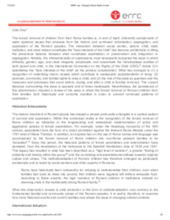How and why Roma children become separated from their families becomes a complicated intertwining of legal and social realities. Here, there is an intersection of three vulnerable points of oppression, namely ethnicity, gender, and age. As illustrative of the often complex manner in which children become forcibly removed, several themes emerge and re-emerge within the current systems of imprisonment, institutionalization, adoption, and solutions which fail to acknowledge how general policies and practices ultimately discriminate, exacerbate, and perpetuate the current plight of the Roma peoples. There is a need to consider alternative remedies both within the criminal and penal systems as well as to acknowledge and transform the biases and remedies available under the social work system. When a child is forcibly removed from the family, the child’s best interest becomes paramount although the ultimate ramifications impact the individual, the family, and the Romani people as a whole. A child protection system must therefore strive to acknowledge the particular vulnerabilities that arise for Roma children and Roma families and the resulting practices must be geared towards future, long term solutions rather than the application of policies that ultimately perpetuate continued patterns of oppression and assimilation.

